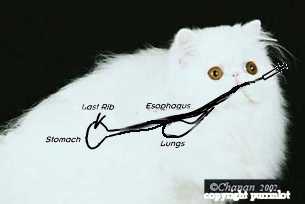Tube Feeding Help for a new born kitten - a "how to" tutorial
Saving Lives: Raising Newborn Kittens from Birth to Weaning. The reasons newborns die and what you can do to save their lives. 11 pages. This e-book is so detailed, it even list colors of stool to know what might be needed by your kitten. Great advice for newborn births to 4 weeks. This e-book contains years of wisdom. When I first began breeding, I thirsted for reading materials to help teach all the things I needed to know. No single book taught me what I learned over time. This e-book will teach you those 10+ years of experience and the important things things to help your newborn kittens!
Tube Feeding
The following is to be used as a guide only. If you have never tube fed a cat or kitten before, I'd highly suggest having your vet teach you how to do this. Below, you will find a few photos to help illustrate tube feeding. I use either a 10 cc or 12 cc Luer Lock syringe. Some tubes have Luer Lock ends. I use a #5 Fr.(1.7mm) feeding tube on newborns. A #5 feeding tube is very fine and a good size for newborns.
You may want to use a #7 or #8 feeding tube on larger kittens. I also like the red rubber tubes as they are more flexible.
Very Important: make certain you purchase a scale for your cattery that weighs ounces to the nearest quarter or better. And one last note, you might should read our e-book on Saving Lives, where I go into much more detail on everything I've learned over the years on how to save kittens' lives. You can purchase and download the e-book here or by clicking the image of the book's cover above.

Weigh your infant. The baby should be gaining a little each day. If you find the kitten is not gaining, but maintaining, he may need a little supplementing help, perhaps one to two meals a day. About 3-4ccs of milk for a kitten weighing in at about 4 oz is recommended.

If the kitten is losing and not maintaining, he may need more meals. Feed him several small meals through out the day, i.e. 3 ccs every 3-4 hours. Adjust milk as per weight on the kitten.

Handle your kitten on a clean surface. Tubing is an easy process once you learn. You will find it works nicer than a bottle. It's easier, faster, safer, and doesn't make the kitten become so dependent on you and your bottle's nipple, allowing the baby to return more naturally to the mother's teats for more meals. Keep a journal. Know what and how much is being supplemented to the diet.

Measure to the beginning of the last rib cage with the feeding tube and measure from the mouth to the rib. My finger is pointing at the last rib on this kitten. See the diagram at the top of this page for more details.

This is where the tube measured to the kittens last rib. Clean the tube with warm water after marking it and remember to re-measure every few days, as babies do grow pretty fast.

Mark where the tube is to be measured with a permanent marker. When it is inserted in the mouth and down the throat, insert the tube until you reach your mark.

Insert the tube inside the mouth centered and glide it into the back of the throat and down into the stomach. The tube should glide easily down the throat. If it doesn't, pull out and try again. This is the easiest way to know you are not entering into the lungs. I have found sometimes the baby will close and tighten the throat for a second after you begin. Allow the kitten to relax his throat and if it slides in with ease, continue. Ootherwise remove. Anytime you are tube feeding consider the possible need for amoxi.
 I like to add my kitten milk into a small glass, (a shot glass is perfect for this) making it easier to measure into the syringe. I most often use Just Born Milk and I prefer the pre-made liquid to avoid making it inconsistently.
I like to add my kitten milk into a small glass, (a shot glass is perfect for this) making it easier to measure into the syringe. I most often use Just Born Milk and I prefer the pre-made liquid to avoid making it inconsistently.

Draw the milk up into the syringe to the amount you plan to feed per the one feeding only. Make sure you clean the feeding tube and refrigerate after each use. You can draw up water just like the milk and avoid taking the tube off of the syringe each time. Store in a tightly sealed container. Do not use the same tube between kittens.

One happy fed baby and ready to return to his mommy. :-)
Tube feeding is very helpful, mostly because you put the milk into the stomach without chancing getting it in the lungs, and you know exactly how much the kitten eats. For more information, please visit and read CFA's article on tube feeding.
If your baby still needs help, perhaps a nebulizer might work.





 Back to our Guided tour
Back to our Guided tour
